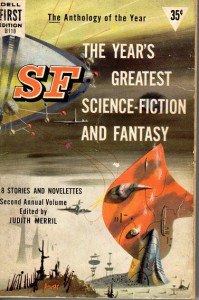Book Review: The Year’s Greatest Science-Fiction and Fantasy Second Annual Volume edited by Judith Merril
This 1957 volume contains speculative fiction stories from magazines published in roughly the previous year, hand-picked by the editor to represent the best the field had to offer at the time. (I’ve previously reviewed the fifth annual, which switched the title from “Greatest” to “Best.”) It contains eighteen stories and articles, beginning with “The Man Who Liked Lions” by John Bernard Daley (an unusual person spends the day at the zoo; he isn’t too impressed with the human visitors) and finishing with “The Anything Box” by Zenna Henderson (a teacher notices that one of her students has an imaginary box of wonders–or is it imaginary?)
“The Anything Box” is the best story in the collection–Ms. Henderson was a first-grade teacher herself, and it shows in her descriptions of the students and their personalities. And also in the dialogue of Alpha, the teacher kids won’t remember fondly at all, even while she prides herself on the discipline she inflicts. The use of imagination, and its perils, are well-represented here.
Also of interest: “All About ‘The Thing'” by Randall Garrett, a summary in rhyme of the classic John W. Campbell story “Who Goes There?” Ms. Merril mentions in her introduction to the next piece, “Put Them All Together, They Spell Monster” by Ray Russell, how disappointed she was that Hollywood in the Fifties decided to go with sci-fi creature features for their movies, instead of thoughtful SF like “Destination Moon.” The piece itself is a parody of the plots of monster movies, with a bit of extra spice because it first appeared in Playboy. (No actual sex or naughty words.)
“Grandma’s Lie Soap” by Robert Abernathy takes a fantastical premise–a soap that prevents the user from telling untruths, and follows it to a logical conclusion, only to present a new dilemma in the last paragraphs, one that perhaps makes the main character’s actions more dangerous than he’d thought.
Theodore Sturgeon’s “The Other Man” should be talked about a bit. An abused woman asks her ex-boyfriend, now a renowned psychiatrist, to treat her awful husband. The story has a unique take on the habit abusive people have of suddenly being the most loving, wonderful person you fell in love with before going back to being abusive. The therapy works, but something of value might have been lost in the process.
Many of the stories have the theme of communication, with others or with oneself. In the afterword, Judith Merril notes that the previous year’s stories had been marked by cynicism and pessimism, while this crop is somewhat more hopeful. She also notes that the pressure for conformity in the greater society led to more use of science fiction and fantasy as metaphors for current events and social ills.
I have not even mentioned several famous writers who got their works in; Isaac Asimov, J.G. Ballard (his first published story!), Algis Budrys, Damon Knight, C.M. Kornbluth and Mack Reynolds. Their stuff is pretty good too.
Be aware that there is period sexism in the stories, (all the authors but Zenna Reynolds were white men) and some ethnic stereotyping.
Overall, a fine collection, worth picking up if you see it–also check your library for this or later volumes.


You’ve taken me back to grade 5, Scott. One of my favorite books was Mrs. Piggledy Wiggledy. She would pop in to help families who were struggling with discipline and one of the stories involved soap. I loved it. And had long forgotten it! Thank you. I’m going to go and google her now.
Those were indeed fun books!
Wow Scott, only you could get me thinking about looking up a 1950s anthology of SF. I don’t even read Science fiction. I’m totally curious of the abusive husband story. Keep letting us know about these hidden classics. Who knew?
It’s amazing what you can find at library sales or garage sales or the deep discount bin at used book stores.
I like that the theme tends to be around communication with others and ourselves. Thanks for the heads up for what’s in the books and what may or may not be ‘politically correct’ these days.
It’s important for me to give heads up on content as I have a varied audience, not all of whom are as bloodthirsty and callous as I am.